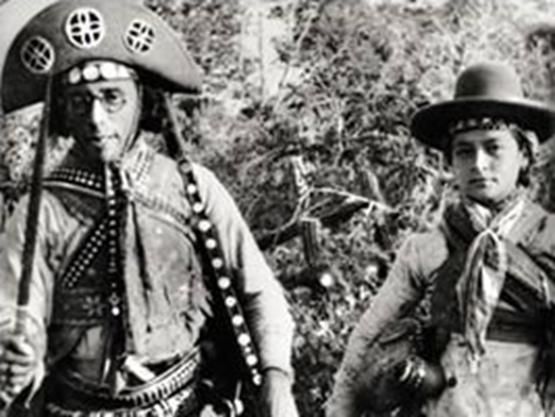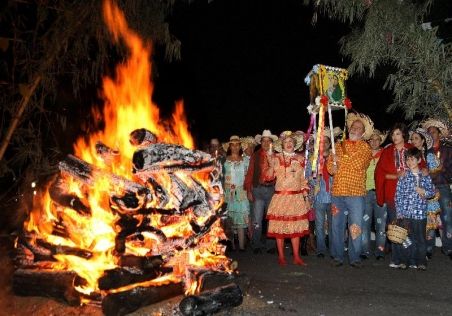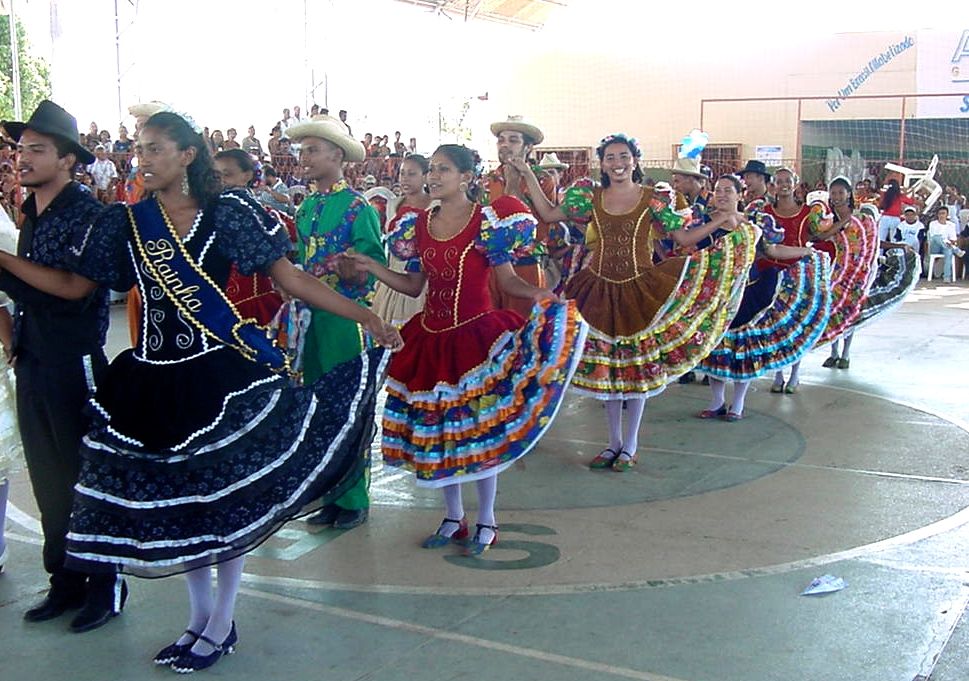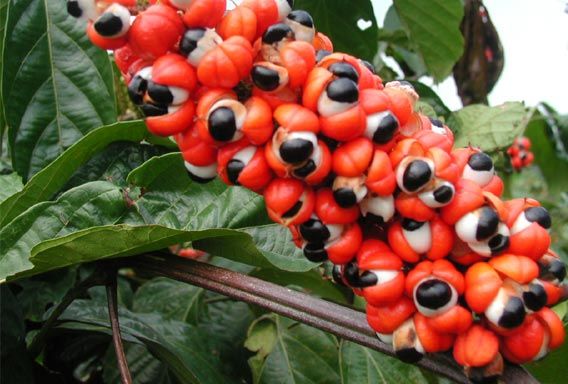To fully appreciate the wonders of Brazil one must understand some of the history and culture of the country. Brazil is so very much more than soccer and Carnaval.
I've decided to start posting monthly articles about either an aspect of Brazilian culture or a description of a historic figure or era in order to increase our members knowledge and appreciation of the incredible country.
================================================================
Lampião & the Cangaceiros (Brazil's version of the Wild, Wild West) photo - Lampião & Maria Bonita (Brazil's Bonnie & Clyde)
photo - Lampião & Maria Bonita (Brazil's Bonnie & Clyde)
Introduction
Between the late nineteenth and early twentieth centuries (beginning of the Republic), there emerged, in northeastern Brazil, groups of armed outlaws know as the "Cangaçeiros" (highwaymen). These groups appeared primarily as a result of the poor social conditions of the northeastern region. The plantations, which concentrated land and income in the hands of farmers, leaving the majority of the population on the margins of society.
Understanding The Cangaço
So, we can consider the highwaymen as a social phenomenon, characterized by violent behavior by the bandits. Those, who belonged to armed gangs, fear spread through the northeastern 'outback'. They promoted the looting of farms, attacking trains and kidnap farmers to obtain ransoms.
Those who respected and deferred to the orders of the bandits did not suffer, but rather were often helped by them. This attitude earned the outlaws the respect and admiration of the people of the time.
The bandits did not live in fixed locations. They had a nomadic life, moving from one city to another. Arriving in cities they asked the local residents for resources and help. Those who refused to help the gang suffered violent reprisals.
Because they refused to obey the laws set forth by the government, they were constantly harassed by the police. They wore leather clothes and hats to protect their bodies from the trails thorny vegetation the "Caatinga". They also possessed infinite knowledge the northeastern territory (water sources, grass, soil types and vegetation) which helped them to escape and cache their stolen loot.
There were many bands of outlaws. However, the most well known and feared at the time was controlled by Lampião (Comma Ferreira da Silva), also known by the nickname "King of Cangaço." Lampião's band of cutthroats was active in the northeastern hinterland during the 1920s and 1930s. He died in an ambush with his wife Maria Bonita and other outlaws, on July 29, 1938. All of the members of the gang were decapitated and their heads put on public display, because the government wanted to frighten the general population and thus discourage this practice in the region.
With the destruction of Lampião's band, other groups of bandits, already weakened, were disarticulated once and for all in the late 1930s.
=================================================================
If there are any aspects of the culture or historical periods you'd like to know about send my your request by PM and I will put it up as a monthly feature.
Cheers,
James
expat.com Experts Team
History and Culture of Brazil
Festa Junina (June Festivals)
Festa Junina. For those of you who are newcomers to Brazil, visitor or anyone else who doesn't have a full understanding of the roots of Festa Junina I will give a brief summary. Festa Junina is probably second only to Carnaval in popularity with the Brazilian people.
The typical June festivals are to celebrate Saint Anthony - June 13, Saint John - June 24 and Saint Peter - June 29. These celebrations are steeped in traditions that for the most part were brought to Brazil from Europe during colonization.
Bonfires and Mast with image of St. John - The tradition of lighting bonfires and the mast comes from the story that Saint Isabel (Mother of John the Baptist) had agreed to light a large bonfire and raise a mast in order to inform Mary (Mother of Jesus) of the birth of her baby John. The quadrilha
The quadrilha
Quadrilha (square dance)and Caipira Wedding - as the story goes the dance was brought from France, it tells the story of a wedding. Here it has become a caipira (hillbilly) wedding complete with the pregnant bride-to-be, reluctant groom and irate father of the bride with his shotgun who obliged the couple to wed. Casamento Caipira (Hillbilly Wedding).
Casamento Caipira (Hillbilly Wedding).
Festa Junina penants - Originally the flags were much larger and had images of the saints. These were soaked in water (The traditional Washing of the Saints) which in turn were passed over the festival participants as a form of purification. They evolved into smaller multicolored penants that still serve the same purpose.
The most wonderful part of all is the great variety of regional dishes that have become associated with Festa Junina. The Brazilian culture is very rich indeed. ENJOY!
Cheers,
James
expat.com Experts Team
BRAZILIAN FOLKLORE - The Legend of the Guaraná Fruit
Im sure that almost everyone who comes to Brazil has tried the soft drink known as Guaraná or experimented with the energetic Guaraná powder. How many of you know the legend behind the Guaraná fruit? It forms a very interesting part of the Brazilian Folklore.
In the middle of the Amazon forest, lived the Maué Indians and among them a young couple who were very happy and loved by whole tribe. However, their happiness was shattered by the sadness of not having children.
Advised by the shaman, they decided to seek help from Tupã (their God). They asked him to bless them with a child.
Months later, the young Indian woman gave birth to a boy.
The small Indian grew healthy and happy. He was well liked by everyone, he was very kind, creative, helpful and full of joy.
The Indian boy was the darling of the tribe and his family much admired.
The fame of child spread through the forest and came to the attention of Jurupari, an evil spirit. Jurupari full of envy began to follow the small Indian boy. Since he could become invisible, nobody saw.
One day, the Indian boy left alone to gather fruit in the forest. Jurupari took advantage of the occasion and transformed himself into a poisonous snake that bit the boy. The little Indian child was killed almost instantly. The venom of the snake was too powerful for his frail little body.
Concerned by the childs delay in returning to the village, several Indians left the village and scoured the woods to look for him.
When they found the child all of them were grief stricken. Just then, thunder and lightning fell from heaven. The Indians claimed to be the lament of Tupã. Great sadness descended over the village.
The mother of the dead child received a message from Tupã saying that they should remove the child's eyes and bury them on the spot where he died.
The Indians obeyed the request made by their God and the mother buried the childs eyes where his body had been found. Some time thereafter in the place where they had buried the child's eyes, a beautiful little plant sprang up, the Guaraná, with red fruit the insides of which looked just like the little boy's eyes.
Cheers,
James
expat.com Experts Team
Just thought it might be interesting to bring this thread back up to the top of the list for those of you who would like to focus a bit more the culture and traditions of this wonderful country than on our current economic and political woes.
Cheers,
James
expat.com Experts Team









